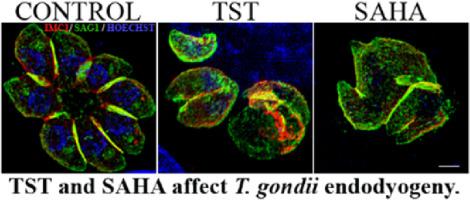International Journal for Parasitology: Drugs and Drug Resistance ( IF 4 ) Pub Date : 2020-12-17 , DOI: 10.1016/j.ijpddr.2020.12.003 Carlla Assis Araujo-Silva 1 , Wanderley De Souza 1 , Erica S Martins-Duarte 2 , Rossiane C Vommaro 1

|
The redirectioning of drugs in the pharmaceutical market is a well-known practice to identify new therapies for parasitic diseases. The histone deacetylase inhibitors Tubastatin A (TST) and Suberoylanilide Hydroxamic Acid (SAHA), firstly developed for cancer treatment, are effective against protozoa parasites. In this work, we aimed to demonstrate the activity of these drugs as potential agents against Toxoplasma gondii, the causative agent of toxoplasmosis. TST and SAHA were active against different genotypes of Toxoplasma gondii, such as, RH (type I), EGS (I/III) and ME49 (type II) strains. The IC₅₀ values for the RH strain were 19 ± 1 nM and 520 ± 386 nM for TST and 41 ± 3 nM and 67 ± 36 nM for SAHA, for 24 and 48 h, respectively. Both compounds were highly selective for T. gondii and their anti-proliferative effect was irreversible for 8 days. The calculated selectivity indexes (39 for TST and 30 for SAHA) make them lead compounds for the future development of anti-Toxoplasma molecules. Western blotting showed TST led to a significant increase of the nuclear histone H4 and a decrease of H3 acetylation levels. Treatment with 1 μM TST and 0.1 μM SAHA for 48 h decreased the amount of global α-tubulin. Fluorescence and electron microscopy showed that both drugs affected the endodyogeny process impairing the budding of daughter cells. The drugs led to the formation of large, rounded masses of damaged parasites with several centrosomes randomly dispersed and incorrect apicoplast division and positioning. TST-treated parasites showed a rupture of the mitochondrial membrane potential and led to a failure of the IMC assembling of new daughter cells. SAHA and TST possibly inhibit HDAC3 and other cytoplasmic or organelle targeted HDACs involved in the modification of proteins other than histones.
中文翻译:

HDAC 抑制剂 Tubastatin A 和 SAHA 影响寄生虫细胞分裂,是潜在的抗弓形虫化疗药物
在制药市场上重新定向药物是一种众所周知的做法,用于确定寄生虫病的新疗法。组蛋白去乙酰化酶抑制剂 Tubastatin A (TST) 和 Suberoylanilide Hydroxamic Acid (SAHA),首先开发用于癌症治疗,对原生动物寄生虫有效。在这项工作中,我们旨在证明这些药物作为对抗弓形虫(弓形体病的病原体)的潜在药剂的活性。TST 和 SAHA 对弓形虫的不同基因型具有活性,例如 RH(I 型)、EGS(I/III)和 ME49(II 型)菌株。在 24 小时和 48 小时内,RH 菌株的 IC 5 值对于 TST 分别为 19 ± 1 nM 和 520 ± 386 nM,对于 SAHA 分别为 41 ± 3 nM 和 67 ± 36 nM。两种化合物都具有高度选择性弓形虫及其抗增殖作用在 8 天内不可逆。计算出的选择性指数(TST 为 39,SAHA 为 30)使其成为未来抗弓形虫开发的先导化合物分子。蛋白质印迹显示 TST 导致核组蛋白 H4 显着增加和 H3 乙酰化水平降低。用 1 μM TST 和 0.1 μM SAHA 处理 48 小时会降低整体 α-微管蛋白的量。荧光和电子显微镜显示这两种药物都会影响内生过程,从而损害子细胞的出芽。这些药物导致大量圆形受损寄生虫的形成,其中几个中心体随机分散,并且顶端质体分裂和定位不正确。TST 处理的寄生虫表现出线粒体膜电位的破裂,并导致新子细胞的 IMC 组装失败。SAHA 和 TST 可能会抑制 HDAC3 和其他细胞质或细胞器靶向 HDAC,这些 HDAC 参与了组蛋白以外的蛋白质修饰。



























 京公网安备 11010802027423号
京公网安备 11010802027423号